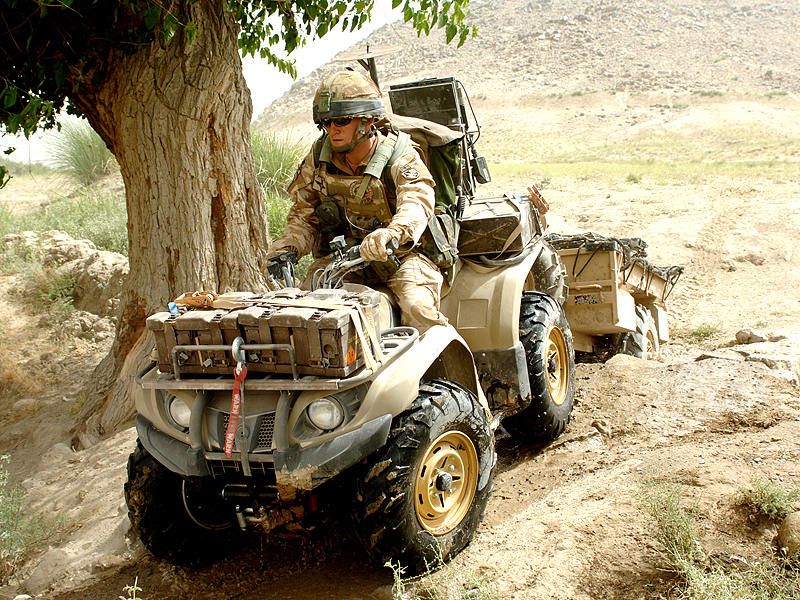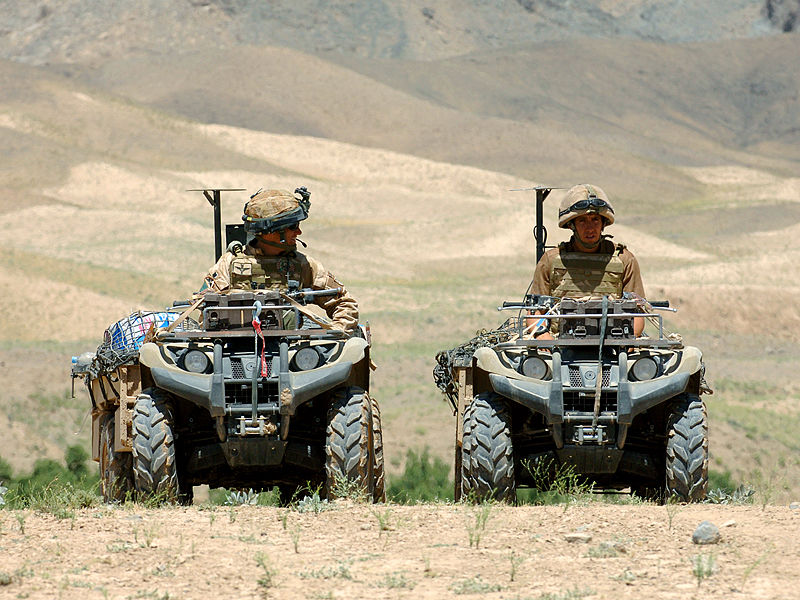I've been "out of range" for few days and chomping at the bit to get back to this discussion.
Agreed: The ATV only carries the weapons for the Det.
So what?
Most Dets don't have enough bodies to man all the weapons. This is due to the need to carry the weapons, tripods, sights, tools, spares...... and enough ammo to be useful. ATV? Problem solved. Trigger pullers are not is short supply. Weapons and ammo for trigger pullers are.
I'm going to propose a couple of "what if" scenarios.
What if, in 1982, the Brits had had access to 500 kg ATVs capable of hauling 750 kg of gear across the Falklands?
2 Para marched 21 km and then had to lay up to catch their breath after humping loads of more than 100 lbs each. At that they only managed to move 2x 81 mm tubes and 1000 bombs. They had extra MGs but they were scattered all over the battlefield and didn't really come into their own until they were grouped at Platoon, Company and Battalion level. Relocating the guns in a timely manner, and more importantly supplying them with ammunition were a problem. So much so that the Pioneers were assigned as ammo carriers. The Motor Transport platoon, in the absence of Motor Transport was assigned to D&D at HQ. Wounded remained in place on the battlefield until the festivities ended.
Could supplying the MT platoon with a dozen Quads and a bunch of 1/2 ton trailers have changed the situation?
Could the troops have arrived faster and/or fresher?
Could the Mor Platoon have had more tubes and rounds available?
Could the MGs have been more readily resupplied and relocated?
Could the Pioneers have been freed up to act as an additional Rifle Platoon?
Could Bn have had more direct contact with Brigade using the Quads to run messages to the rear and bring supplies forward?
Could the Bn's assigned RAF FAC made it forward if he had been relieved of his pack and not broken his ankle on the approach march?
Another scenario would be seizing a position and permitting greater dispersal of the available forces due the ability to bring heavier weapons and greater ammunition loads further forward faster than dismounted troops.
I like the Quads for the following reasons:
They are light enough to be transported by all air means from CH-146 on up.
They can draw a trailer of up to 800 kg. Coincidentally that is equivalent to the carrying capacity of the WW2 Platoon Vehicles.
With trailers loads can be pre-staged, reducing turn around time.
Without trailers the Quad can be used as a scouting, courier or supply vehicle. Or even a commanders ride.
In short, they can go everywhere heliborne/airborne troops can go. They are the vehicle that the light forces have been trying to find since WW2.
They permit the distance between the LZ and the Objective to be longer allowing greater probability of masking the LZ and permitting additional troops and supplies to be delivered before the Objective is alerted and they LZ becomes unsafe.
In the defence, they supply logistical support - and together with a batch of Helo delivered bobcats - permit the construction of a stronger defensive position through the ability to move construction materials around the site.
Somebody around here keeps posting articles about unmanned vehicles like the USMC's GUSS:
The intent of the vehicle is to support dismounted troops in the advance.
The alternative unit being tested is the Robotic Mule
which only carries a payload of 180 kg.
Those are in development and cost a fortune
This is available and dirt cheap.
And appreciated....
Testimonial 1
Upgraded quad bikes for British forces in Afghanistan
Posted on June 23, 2009 by Strike-Hold
A shipment of upgraded quad bikes are bound for the front line in Afghanistan to boost troops’ ability to deliver vital combat supplies to Service personnel on the ground.200 of the upgraded all-terrain vehicles and trailers have been ordered for British troops as part of a £5m contract with Yamaha and Logic.The upgrades to the bikes include a left hand throttle which provides a dual throttle fit giving greater manoeuvrability in theatre; and dual stretcher fit on the trailers to evacuate two casualties at a time thereby speeding up emergency aid.
The quad bikes can reach speeds of up to 75km/h, can carry up to almost 160kg with the trailer attached, and are already being used to deliver food, water and ammunition to troops on the front line in difficult to access areas – or where it is more appropriate to offer a lower profile. Even with the trailer attached, they can operate through streams and puddles of up to half their wheel-height.
Major Matt Cansdale of 3rd Battalion The Parachute Regiment, who used the bikes during his recent operational tour, added:
“The quad bikes proved to be reliable and able to go places that no other vehicle could. The equipment that the quad bikes were able to carry enabled us to launch patrols that covered more distance and were longer in duration than would otherwise have been the case, so we were able to push into areas that the enemy did not expect us.”The ability to evacuate casualties effectively and quickly also meant that we could move away from established routes while limiting the risk to our forces.”
Testimonial 2
To address the discrepancy in load carrying numbers cited by the paras and myself - herewith
the Polaris specs
So, I suggest the choice rests between
and
Laser attachment pending. ;D
PS Further to the 1982 "What If" scenario.... in the 105 Lt Guns had been replaced with the M777s Goose Green would have been in range of the beachhead at San Carlos and a couple of Excaliburs would have shut down the 35mm AAs that were used in Direct Fire mode against the Paras.








